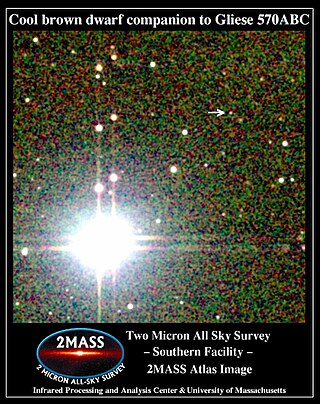Gliese 570
|
Multiple star Gliese 570 |
|
|---|---|

|
|
| 2MASS recording of the system | |
| AladinLite | |
|
Observation dates equinox : J2000.0 , epoch : J2000.0 |
|
| Constellation | Libra |
| Right ascension | 14 h 57.5 m |
| declination | -21 ° 25 ′ |
| Typing | |
| Spectral class | K4 V |
| Astrometry | |
| distance | 19 ly |
| Physical Properties | |
| Dimensions | 0.76 + 0.054−0.047 M ☉ |
| radius | 0.77 +0.09−0.15 R ☉ |
| Luminosity |
0.16 L ☉ |
Gliese 570 is a multiple star system in the constellation Libra , which is about 19 light years away from the Sun and thus represents a star system relatively close to Earth .
Visibility and Exploration
The star system can be seen in the night sky in the constellation Libra and was initially located at a distance of about 25 light years from the sun using the ESA Hipparcos space telescope . Initially, a triple system with a planet the size of Jupiter was assumed . More detailed investigations in the course of the 2MASS program, in particular with the help of the Cerro Tololo Inter-American Observatory in Chile, showed that the distance is only around 19 light years and that the supposed planet is rather an ultra-cool brown dwarf . With a surface temperature of around 500 ° C, it is only slightly warmer than Venus and the coolest brown dwarf known to date. At approximately the size of Jupiter, it has about 50 Jupiter masses .
Star system Gliese 570
Gliese 570 A
The main star of the system, Gliese 570 A, is a main sequence star belonging to the spectral class K4 to K5. It has about 77% of the solar mass , 76% of its diameter and 15.6% of the relative luminosity .
Gliese 570 B
The second largest star in the system is a red dwarf of the spectral class M1 V, comprises about 66% solar mass with 55% solar diameter and 1.9% its luminosity.
Gliese 570 C
Is also a red dwarf and radiates with the spectral class M3 V. It has about 35% of the sun's diameter but only 0.3% of its luminosity.
Gliese 570 D
This brown dwarf of the spectral class T8 has about 50 Jupiter masses “on the scales” and only radiates in the infrared range.
future
The main star Gliese 570 A has a life expectancy of around 30 billion years and could thus outlive the sun by around twice as much at 11 billion years.
It would take the fastest man-made spacecraft to date , Helios 1 and 2 , approximately 82,300 years to cover the current distance between the solar system and Gliese 570.